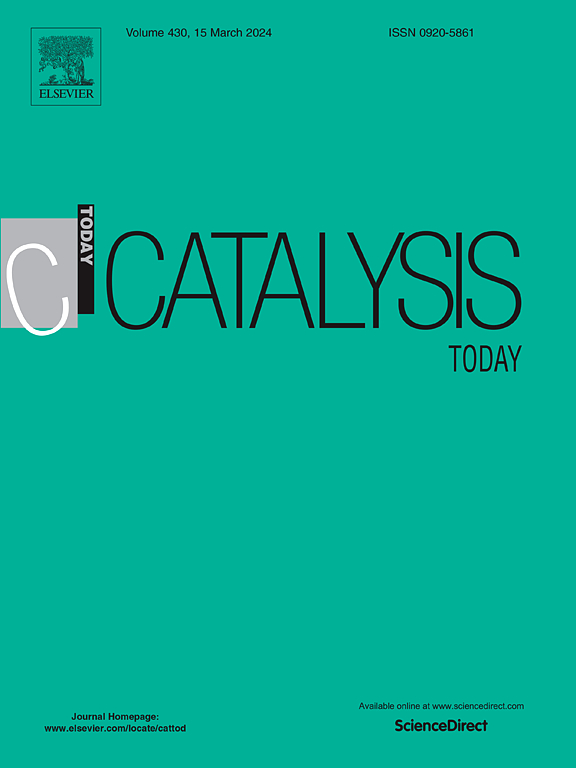使用从PET塑料废物中提取的连接剂,使用磺化MIL-101(Cr)催化剂,通过棕榈油废水酯化生产生物柴油
IF 5.3
2区 化学
Q1 CHEMISTRY, APPLIED
引用次数: 0
摘要
棕榈油脂肪酸馏出物(PFAD)是棕榈油精炼的副产品,作为生物柴油的原料已引起人们的兴趣。与此同时,PET废物的不断积累也带来了严重的环境挑战。在本研究中,以PET废料为连接剂的磺化金属有机骨架(MOF)为催化剂,采用不同的醇催化PFAD酯化。当使用甲醇作为溶剂时,在60-120°C的温度范围内,始终观察到高游离脂肪酸(FFA)转化率(~ 100 %)。相比之下,在高温下,乙醇和异丙醇的FFA转化率显著提高,在90 °C和120 °C时分别达到99.4 %和99.7 %,这是由于分子相互作用的增强。这种增强是由于改善了溶剂化效应和提高了分子迁移率,从而促进了在较高温度下的酯化反应。较高的醇链长度会增加活化能,从而对酯化效率产生负面影响。更高的催化剂与原料(C/F)比也提高了转化率。mof中的磺酸基(SO3H)含量起着至关重要的作用:MCS30催化剂(30 % SO3H连接剂)与甲醇、乙醇和异丙醇的FFA转化率最高,其次是20 %和10 %的连接剂。这是由于丰富的Brønsted酸位点在反应过程中促进了质子的捐赠。MCS30催化剂也表现出优异的可重复使用性,在四个循环中,FFA转化率仅从99.7 %略微下降到95.2% %。总的来说,这种方法提供了双重环境效益:减少PET塑料废物,并通过PFAD酯化实现可持续的生物柴油生产。本文章由计算机程序翻译,如有差异,请以英文原文为准。
Biodiesel production through the esterification of palm oil effluent using sulfonated MIL-101(Cr) catalyst using linkers derived from PET plastic waste
Palm oil fatty acid distillate (PFAD), a byproduct of crude palm oil refining, has gained interest as a biodiesel feedstock. Concurrently, the growing accumulation of PET waste poses serious environmental challenges. In this study, sulfonated metal-organic frameworks (MOF) using linkers derived from PET waste were employed as catalysts for PFAD esterification using various alcohols. When methanol was employed as the solvent, high free fatty acid (FFA) conversions (∼100 %) were consistently observed within the temperature range of 60–120 °C. In contrast, FFA conversion increased significantly with ethanol and isopropanol at elevated temperatures, reaching 99.4 % and 99.7 % at 90 °C and 120 °C, respectively, due to enhanced molecular interactions. This enhancement is attributed to improved solvation effects and increased molecular mobility, which facilitate esterification at higher temperatures. Higher alcohol chain length negatively impacted esterification efficiency due to increased activation energy. A greater catalyst-to-feedstock (C/F) ratio also improved conversion. The sulfonic acid group (SO3H) content in MOFs played a crucial role: the MCS30 catalyst (30 % SO3H linker) yielded the highest FFA conversions with methanol, ethanol and isopropyl alcohol, followed by the 20 % and 10 % counterparts. This is attributed to the abundance of Brønsted acid sites facilitating proton donation during the reaction. MCS30 Catalyst also exhibited excellent reusability, with the FFA conversion dropping only slightly from 99.7 % to 95.2 % over four cycles. Overall, this approach offers a dual environmental benefit: mitigating PET plastic waste and enabling sustainable biodiesel production via PFAD esterification.
求助全文
通过发布文献求助,成功后即可免费获取论文全文。
去求助
来源期刊

Catalysis Today
化学-工程:化工
CiteScore
11.50
自引率
3.80%
发文量
573
审稿时长
2.9 months
期刊介绍:
Catalysis Today focuses on the rapid publication of original invited papers devoted to currently important topics in catalysis and related subjects. The journal only publishes special issues (Proposing a Catalysis Today Special Issue), each of which is supervised by Guest Editors who recruit individual papers and oversee the peer review process. Catalysis Today offers researchers in the field of catalysis in-depth overviews of topical issues.
Both fundamental and applied aspects of catalysis are covered. Subjects such as catalysis of immobilized organometallic and biocatalytic systems are welcome. Subjects related to catalysis such as experimental techniques, adsorption, process technology, synthesis, in situ characterization, computational, theoretical modeling, imaging and others are included if there is a clear relationship to catalysis.
 求助内容:
求助内容: 应助结果提醒方式:
应助结果提醒方式:


